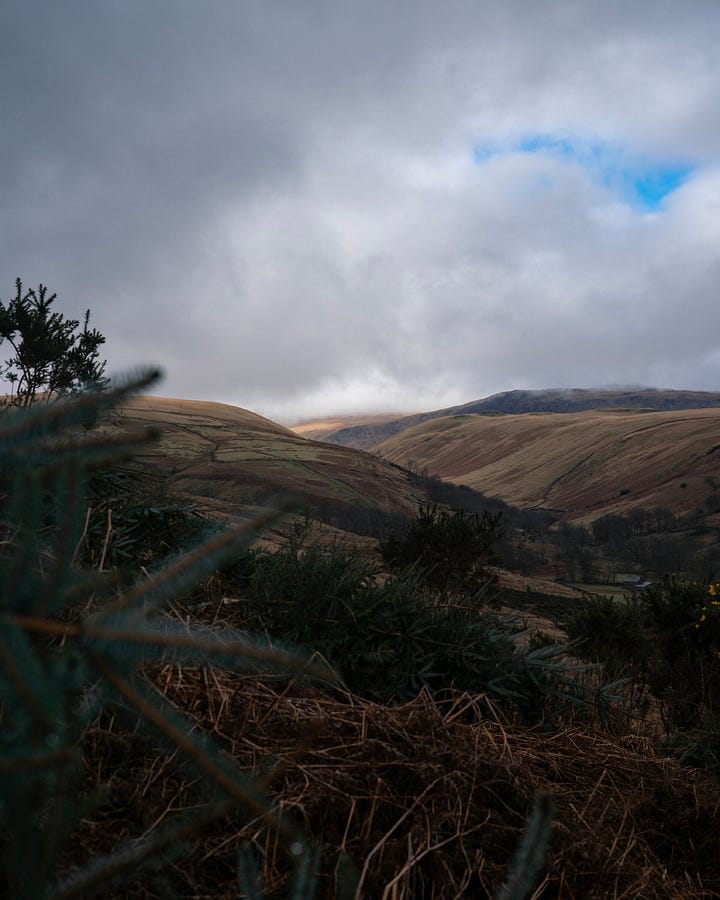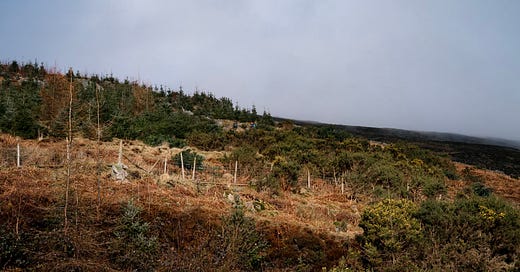My leg muscles are still burning from the hike up the slope, steep and strewn with rocks, dense patches of crisp dead bracken, brambles that seem to grab at my ankles with intention and slippery logs and branches, remains from old forestry work. The way ahead is a boulder field; car sized chunks of Eskdale granite, sharp and rough but good for scrambling. I grab a rock ledge with one hand and haul myself forward and upwards to the next boulder. Clouds hide the summit of Scafell at the head of the valley as a shower passes through, when it clears, the very top of the mountain is left dusted with snow. The steady rumbling of a chainsaw idling permeates through my ear defenders as I place the saw onto the rock and pull myself up to where a small sitka spruce, not much bigger than a Christmas tree, has taken root in a space between boulders. The saw screams into life, reverberating loudly through the valley as I cut the tree at the base, taking great care not to hit the rocks whilst making sure the cut is low enough to prevent it growing back. The stiff needles pierce my skin and a long ribbon of bramble scratches across my forearm as I grab the tree and toss it down the slope. A young birch is revealed as the spruce falls, blinking in the light, liberated from its green prison; I give it a little pat and move on to the next spruce a short scramble up the hill. For 20 days this will be our mission, three or four of us clambering up and down steep fell sides carrying chainsaws and fuel cans, liberating birches, willows, rowans and the occasional oak and cutting out spruce trees, a fast growing American species planted for timber with devastating impacts for biodiversity. In this remote valley, work is being done to restore the species that would have thrived here before the intensification of agriculture and the advent of commercial forestry and it feels good to be helping Nature reclaim the land once more.
This is what work looks like in winter. Outside in all weathers, on the fells or in the woods working for conservation organisations trying to do what we can to improve habitats for wildlife and to stem the tide of biodiversity loss. I do this as a solo contractor, but also as part of a co-operative, each of us bound together by the desire to make a living doing what we love and a commitment to be good stewards to the land. Why do we do this work? Why choose to spend all winter battling the elements, getting bashed and battered, balancing precariously on steep slopes with chainsaws? For me, it is the daily close proximity to Nature, to the earth and to the elements, but also the sense of adventure that comes from working in remote places in all conditions, hauling gear, overcoming challenges and having fun in a type 2 kind of way.




And why shouldn’t our daily lives be an adventure? Why wait until the weekend to live? When I began to move away from illustration towards working in the woods, adventure was what I was seeking, a way of feeling more alive, more awake, more present in each moment. I think a lot about the nature of work, what it means and why we must dedicate so much of our lives to the pursuit of wealth instead of joy and beauty. I’m glad that somewhere along the way I was bold enough to reject the normal pattern of 9-5 monotony and strike out on my own path to make a life as well as a living.
The winter conservation contracting season runs from around the start of November to the end of March, around the breeding patterns of birds and dormice, which means that this is our last week. Although the work is rewarding and fun, it is a relief to get to the end of the season. It is hard on the body, battering and bruising and I will be glad to move on to different projects for a while.
To work in conservation in the UK is a strange business. Typically we work on nature reserves, which are just small fragments of land, the last refuges for wildlife in a landscape either farmed or developed to the detriment of wild Nature. These reserves often consist of one type of habitat and become home to a small assemblage of plants and creatures that thrive in that particular niche - but all dynamism is lost. Much practical conservation effort is focused on preserving these habitats for the small range of species that exist there, preventing that habitat from developing into something else, pressing pause on the natural process of succession. So fragmented are our wild spaces that if one habitat were to change into another, the species that depend on these ecosystems have nowhere left to go. In other larger reserves or landscape scale projects, we are often employed to create dynamism rather than to halt it. We are doing the work that large herbivores or wild eco-system engineers such as beavers or wild boar would be doing if they had not been eradicated from the landscape, creating open spaces in woodlands or building leaky dams in rivers to slow the flow, or re-instating coppice cycles to increase diversity of age class and structure for the benefit of dormice and other creatures that thrive in varied habitats. Perhaps most often, we are engaged in reversing the damage done by those before us, removing invasive species like Rhododendron or felling non-native conifers to restore ancient woodlands. It is not without irony that the main tools of the conservationist are the chainsaw and pesticides.
I don’t agree with the rationale behind some of the projects we work on, it feels like a lot of tinkering around the edges, rather than tackling the problems head on. Aldo Leopold sums up my feelings on conservation well is this quote from A Sand County Almanac:
“All conservation of wildness is self-defeating, for to cherish we must see and fondle, and when enough have seen and fondled, there is no wilderness left to cherish.”
But we are forced to work within an imperfect system, making the most of what we have and doing what we can to at least slow the decline of Nature in this already Nature depleted country.
Although sometimes conservation work can feel futile in the face of such huge challenges, when we look back at the end of each winter to the projects we’ve completed, trees we’ve planted, woodlands we’ve restored, habitats we’ve created and adventures we’ve had at least we know we have done the best we can to stand up for Nature when so many have waged war against it.
Well that’s all for this week. A note on the photography - I always take my camera to work and love to try and tell the stories behind the work we do, but it’s hard to take good photos and chainsaw at the same time! One winter I’d like to dedicate more time to this, a short film maybe?
With warm wishes,
Andrew, Emma and Benji x






Such important conservation work that you do Andrew. I’m glad that you enjoy the hard graft that you put in and hope you know that you’re appreciated 💫
Interesting insights into the conservation going on in the Lakes - you do such hard work but so important! I used to come up quite regularly and watched as they worked on the Sitka spruces on Latrigg - I'm going to be up there in the summer so it'll be interesting to see how that fell has changed.